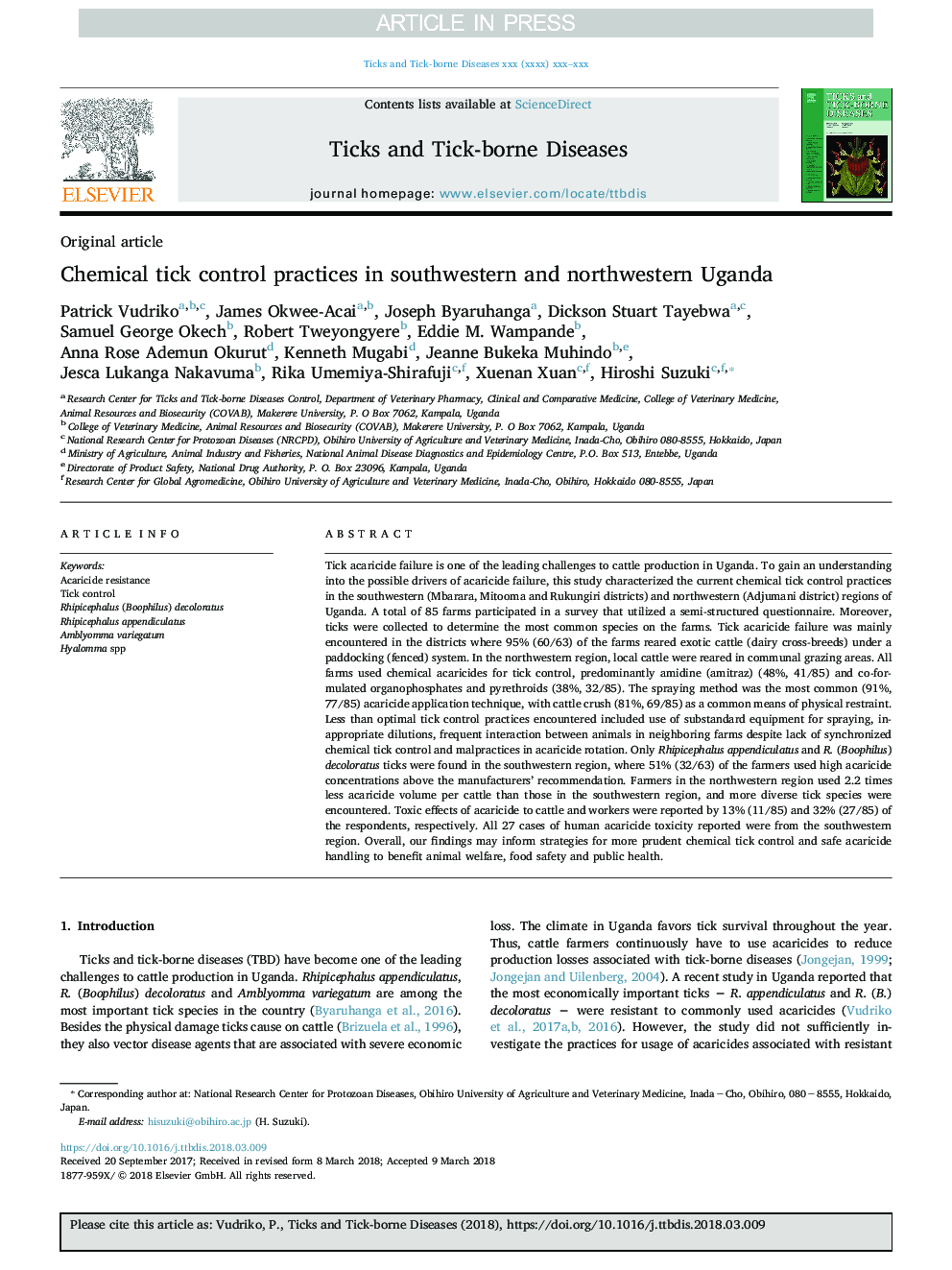| کد مقاله | کد نشریه | سال انتشار | مقاله انگلیسی | نسخه تمام متن |
|---|---|---|---|---|
| 8507274 | 1555960 | 2018 | 11 صفحه PDF | دانلود رایگان |
عنوان انگلیسی مقاله ISI
Chemical tick control practices in southwestern and northwestern Uganda
ترجمه فارسی عنوان
شیوه های کنترل بیماری های شیمیایی در جنوب غربی و شمال غربی اوگاندا
دانلود مقاله + سفارش ترجمه
دانلود مقاله ISI انگلیسی
رایگان برای ایرانیان
کلمات کلیدی
موضوعات مرتبط
علوم زیستی و بیوفناوری
علوم کشاورزی و بیولوژیک
علوم دامی و جانورشناسی
چکیده انگلیسی
Tick acaricide failure is one of the leading challenges to cattle production in Uganda. To gain an understanding into the possible drivers of acaricide failure, this study characterized the current chemical tick control practices in the southwestern (Mbarara, Mitooma and Rukungiri districts) and northwestern (Adjumani district) regions of Uganda. A total of 85 farms participated in a survey that utilized a semi-structured questionnaire. Moreover, ticks were collected to determine the most common species on the farms. Tick acaricide failure was mainly encountered in the districts where 95% (60/63) of the farms reared exotic cattle (dairy cross-breeds) under a paddocking (fenced) system. In the northwestern region, local cattle were reared in communal grazing areas. All farms used chemical acaricides for tick control, predominantly amidine (amitraz) (48%, 41/85) and co-formulated organophosphates and pyrethroids (38%, 32/85). The spraying method was the most common (91%, 77/85) acaricide application technique, with cattle crush (81%, 69/85) as a common means of physical restraint. Less than optimal tick control practices encountered included use of substandard equipment for spraying, inappropriate dilutions, frequent interaction between animals in neighboring farms despite lack of synchronized chemical tick control and malpractices in acaricide rotation. Only Rhipicephalus appendiculatus and R. (Boophilus) decoloratus ticks were found in the southwestern region, where 51% (32/63) of the farmers used high acaricide concentrations above the manufacturers' recommendation. Farmers in the northwestern region used 2.2 times less acaricide volume per cattle than those in the southwestern region, and more diverse tick species were encountered. Toxic effects of acaricide to cattle and workers were reported by 13% (11/85) and 32% (27/85) of the respondents, respectively. All 27 cases of human acaricide toxicity reported were from the southwestern region. Overall, our findings may inform strategies for more prudent chemical tick control and safe acaricide handling to benefit animal welfare, food safety and public health.
ناشر
Database: Elsevier - ScienceDirect (ساینس دایرکت)
Journal: Ticks and Tick-borne Diseases - Volume 9, Issue 4, May 2018, Pages 945-955
Journal: Ticks and Tick-borne Diseases - Volume 9, Issue 4, May 2018, Pages 945-955
نویسندگان
Patrick Vudriko, James Okwee-Acai, Joseph Byaruhanga, Dickson Stuart Tayebwa, Samuel George Okech, Robert Tweyongyere, Eddie M. Wampande, Anna Rose Ademun Okurut, Kenneth Mugabi, Jeanne Bukeka Muhindo, Jesca Lukanga Nakavuma, Rika Umemiya-Shirafuji,
